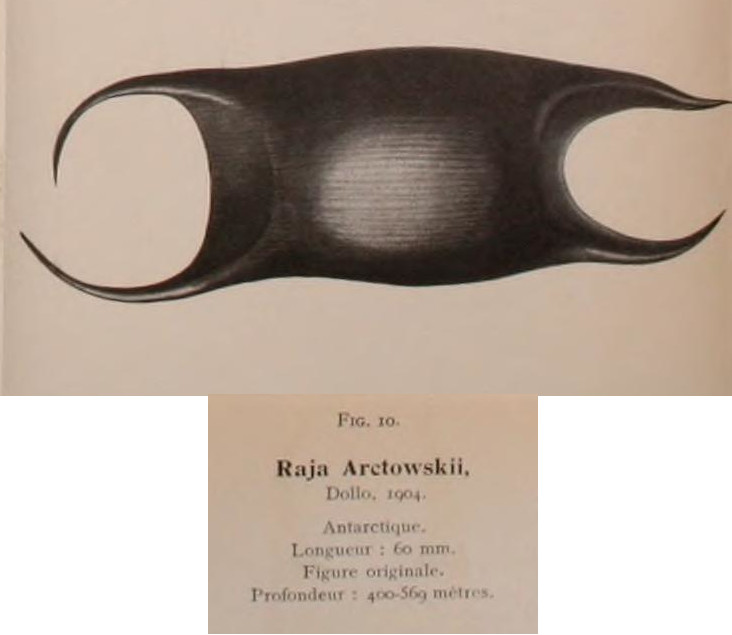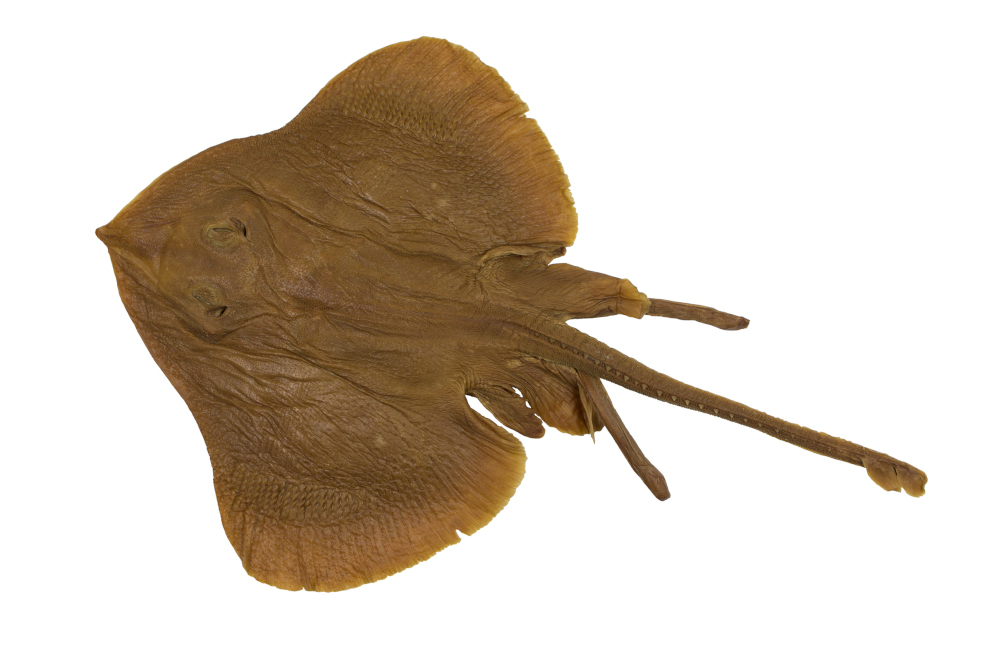Bathyraja arctowskii
(Dollo, 1904)
Classification: Elasmobranchii Rajiformes Arhynchobatidae
Reference of the original description
Résultats du voyage du S. Y. Belgica. Expédition Antarctique Belge. Zoologie. Poissons. 1–240, Pls. 1–12
Résultats du voyage du S. Y. Belgica. Expédition Antarctique Belge. Zoologie. Poissons. 1–240, Pls. 1–12
Image of the original description

Bathyraja arctowskii (Dollo, 1904), Plate 9 fig. 10

Bathyraja arctowskii (Dollo, 1904), Plate 9 fig. 10
Synonyms / new combinations and misspellings
Raja arctowskii
Raja arctowskii
Types
Bathyraja arctowskii
Raja arctowskii
Lectotype: IRSNB: 25 (orig. 3005); Paralectotype: IRSNB: 27 (orig. 3007); IRSNB: 26 (orig. 3006);
Bathyraja arctowskii
Raja arctowskii
Lectotype: IRSNB: 25 (orig. 3005); Paralectotype: IRSNB: 27 (orig. 3007); IRSNB: 26 (orig. 3006);
Description :
Citation: Bathyraja arctowskii (Dollo, 1904): In: Database of modern sharks, rays and chimaeras, www.shark-references.com, World Wide Web electronic publication, Version 12/2025
Please send your images of "Bathyraja arctowskii" to info@shark-references.com

Bathyraja arctowskii (Dollo, 1904), adult, male, 533 mm TL, ZMH 120216 © Dr. Simon Weigmann, Elasmobranch Research Laboratory, Hamburg, Germany

Bathyraja arctowskii (Dollo, 1904), adult, male, 533 mm TL, ZMH 120216 © Dr. Simon Weigmann, Elasmobranch Research Laboratory, Hamburg, Germany
Common names
 Antarctic dark-mouth skate
Antarctic dark-mouth skate
 Antarctic dark-mouth skate
Antarctic dark-mouth skate
Short Description
Diagnosis after STEHMANN, WEIGMANN & NAYLOR, 2021 [29356]: Bathyraja arctowskii is a small (to 61 cm TL) species of the genus Bathyraja with the following set of characters: disc evenly inverse heart-shaped (disc margins distinctly undulated in adult males, not or slightly undulated in others), with broadly rounded outer corners and with body length to mid-cloaca shorter than or equal to tail length from mid-cloaca. Preorbital snout length 8.1–16.2% TL, depending on ontogenetic stage, and distance between first gill slits 14.2–15.9% TL. Orbits moderately large, horizontal diameter 1.3–1.8 times interorbital width. Upper side of disc and tail entirely rough prickly with dermal denticles, underside smooth. Except for alar thorns of mature males, no thorns on disc but only a median row of 19–30 small thorns along tail to first dorsal fin. The thorns become smaller and more widely spaced posteriorly in subadults and adults and are generally wider spaced in large juveniles to adults as compared with small juveniles. Bases of low, more or less equal-sized dorsal fins confluent or with short interspace. Postdorsal tail section very short, 1.7–5.2% TL, with low epichordal caudal lobe which is confluent with second dorsal fin. Dorsal ground color plain dark to medium grayish-brown, often with mostly indistinct scattered pale and dusky spots on disc, posterior pelvic lobes and on sides of tail, occasionally with transverse white pseudoocellus stripe on inner posterior pectorals. Underside mostly plain white or pale, often with gray marked cloaca and gray spots on belly to gill region, occasionally gray spotted posterior pectoral margins, origin and sides of tail, or tail partly dark. Mouth cavity and underside of nasal curtain at least partly, usually completely pigmented medium to dark grayish from very small juvenile stages onwards. Opened clasper tip shows all components typical for Bathyraja species, of which most apparent a long and deep pseudosiphon (ps) along outer edge of dorsal lobe, as well as a massive projection (pj) over entire length of the inner ventral lobe. Clasper terminal skeleton with distal processes of dorsal marginal cartilage (forming external pseudorhipidion) and ventral marginal cartilage (forming external projection), three dorsal terminal cartilages (with dt1 very large and encapsulating terminal skeleton), ventral terminal, and one accessory terminal cartilage. Sexual dimorphism apparent in scapulocoracoid, with post-mesocondyle length longer in females than in males.
Diagnosis after STEHMANN, WEIGMANN & NAYLOR, 2021 [29356]: Bathyraja arctowskii is a small (to 61 cm TL) species of the genus Bathyraja with the following set of characters: disc evenly inverse heart-shaped (disc margins distinctly undulated in adult males, not or slightly undulated in others), with broadly rounded outer corners and with body length to mid-cloaca shorter than or equal to tail length from mid-cloaca. Preorbital snout length 8.1–16.2% TL, depending on ontogenetic stage, and distance between first gill slits 14.2–15.9% TL. Orbits moderately large, horizontal diameter 1.3–1.8 times interorbital width. Upper side of disc and tail entirely rough prickly with dermal denticles, underside smooth. Except for alar thorns of mature males, no thorns on disc but only a median row of 19–30 small thorns along tail to first dorsal fin. The thorns become smaller and more widely spaced posteriorly in subadults and adults and are generally wider spaced in large juveniles to adults as compared with small juveniles. Bases of low, more or less equal-sized dorsal fins confluent or with short interspace. Postdorsal tail section very short, 1.7–5.2% TL, with low epichordal caudal lobe which is confluent with second dorsal fin. Dorsal ground color plain dark to medium grayish-brown, often with mostly indistinct scattered pale and dusky spots on disc, posterior pelvic lobes and on sides of tail, occasionally with transverse white pseudoocellus stripe on inner posterior pectorals. Underside mostly plain white or pale, often with gray marked cloaca and gray spots on belly to gill region, occasionally gray spotted posterior pectoral margins, origin and sides of tail, or tail partly dark. Mouth cavity and underside of nasal curtain at least partly, usually completely pigmented medium to dark grayish from very small juvenile stages onwards. Opened clasper tip shows all components typical for Bathyraja species, of which most apparent a long and deep pseudosiphon (ps) along outer edge of dorsal lobe, as well as a massive projection (pj) over entire length of the inner ventral lobe. Clasper terminal skeleton with distal processes of dorsal marginal cartilage (forming external pseudorhipidion) and ventral marginal cartilage (forming external projection), three dorsal terminal cartilages (with dt1 very large and encapsulating terminal skeleton), ventral terminal, and one accessory terminal cartilage. Sexual dimorphism apparent in scapulocoracoid, with post-mesocondyle length longer in females than in males.
Distribution
Circumantarctic species with its center of distribution in the Atlantic sector of the Southern Ocean [29356] Source: www.gbif.org
Circumantarctic species with its center of distribution in the Atlantic sector of the Southern Ocean [29356] Source: www.gbif.org
Dentition
23 upper and 24 lower parallel tooth rows (22–29 upper and 21–29 lower tooth rows; arrangement similar in subadult male but teeth in quincunx pavement pattern in females, juvenile males and male embryo); individual teeth with pronounced, triangular cusp becoming smaller towards jaw angles (similar in subadult male but with rather low cusp in females, juvenile males and male embryo) [29356]
23 upper and 24 lower parallel tooth rows (22–29 upper and 21–29 lower tooth rows; arrangement similar in subadult male but teeth in quincunx pavement pattern in females, juvenile males and male embryo); individual teeth with pronounced, triangular cusp becoming smaller towards jaw angles (similar in subadult male but with rather low cusp in females, juvenile males and male embryo) [29356]
Remarks
shark-references Species-ID=16055;
shark-references Species-ID=16055;
Parasites (arranged by Jürgen Pollerspöck)
Cestoda
Cestoda
















